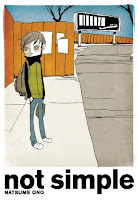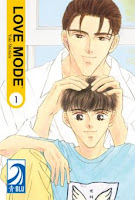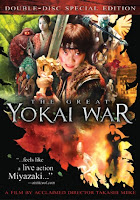 I’ve really been enjoying this month’s Horror Manga Moveable Feast. Earlier this week I noticed that no one had yet mentioned Shin Mashiba’s series Nightmare Inspector: Yumekui Kenbun, which I’m quite fond of. I commented on this on Twitter and also noted that I regretted not coming up with something for the series myself. Lori Henderson, who is doing a wonderful job hosting the Feast over at Manga Xanadu, caught me and encouraged me to go ahead and write something up. And so, please allow me to take a brief moment to show a little bit of last minute love for Shin Mashiba’s Nightmare Inspector: Yumekui Kenbun.
I’ve really been enjoying this month’s Horror Manga Moveable Feast. Earlier this week I noticed that no one had yet mentioned Shin Mashiba’s series Nightmare Inspector: Yumekui Kenbun, which I’m quite fond of. I commented on this on Twitter and also noted that I regretted not coming up with something for the series myself. Lori Henderson, who is doing a wonderful job hosting the Feast over at Manga Xanadu, caught me and encouraged me to go ahead and write something up. And so, please allow me to take a brief moment to show a little bit of last minute love for Shin Mashiba’s Nightmare Inspector: Yumekui Kenbun.
Nightmare Inspector is set in the last few years of the Taishō era in Japan. This series is the only manga that I have read that has been set in this time period. In fact, I haven’t read very many novels that take place during this time, either. The Taishō era lasted from 1912 to 1926. The time period, while not as romanticized as feudal era Japan, is well suited for a series about nightmares and anxieties. World War I was fought between 1914 and 1918. There was an underlying turmoil in Japanese society as its mores, social structures, and political systems were shifting and changing. The increase in Westernization was a concern for many. The Emperor was weak and in poor health. And on September 1, 1923, Tokyo and the surrounding areas were devastated by the Great Kantō earthquake, an event that is important to Nightmare Inspector, as well. The Taishō era was a difficult and trying time for many in Japan.
The basic premise of Nightmare Inspector is fairly simple. Hiruko, once human, has become a baku, a supernatural creature that devours dreams and nightmares for sustenance. The bloodier and the more painful they are for the dreamers, the better tasting they are for him. Those unfortunate enough to be plagued by their nightmares come to the Silver Star Tea House seeking Hiruko’s aid to be rid of them, hoping to find some peace. Hiruko doesn’t tend to be malicious, but he’s not exactly benevolent, either. He gives his patrons exactly what they ask for, and that can be terrifying in and of itself. Their nightmares are tied very closely to their realities; affecting one has profound effects on the other. Very few of the dreamers find a happy ending and even for those that do it is very bittersweet. Hiruko, whose past is slowly revealed as the series progresses, must also face his own darkness.
The exploration of the nightmares is one of the most interesting elements in Nightmare Inspector. The creativity and imagination that Mashiba exhibits is impressive, frequently changing art styles to reflect the dreamers’ individual experiences. Some nightmares are frighteningly realistic while others are more abstract in their portrayal, but they are no less disturbing because of it. And because baku delight in the psychological suffering of others, the dreams often become worse when they become involved. Many of the individuals that come to the Silver Star Tea House are coping with some sort of trauma or painful memories that they are trying to repress. Some of the circumstances may seem a bit far-fetched, but overall the insecurities that they are dealing with will be quite familiar to readers of the series. This is one of the reasons that Nightmare Inspector is so effectively disconcerting.
The manga is consistently dark in atmosphere, but its finale is even more heartrending than anything that comes before it. There are some moments of levity, but they seem so out of place to me that I personally consider those chapters to be scenarios that could only exist in a more optimistic reality. Perhaps they, too, are dreams. Nightmare Inspector does tend to be fairly episodic for most of the series. But underlying all of the individual stories is a certain melancholy and ominousness that surrounds Hiruko. Eventually, the truth of his past is revealed and moments from earlier volumes suddenly become more significant than they may have first appeared. His story, and the complex relationships he has developed with other characters in the series, is actually what draws me most to Nightmare Inspector. It’s not without its faults, but I do love this manga and hope that others give it a try.
This post is part of the Horror Manga Moveable Feast.











